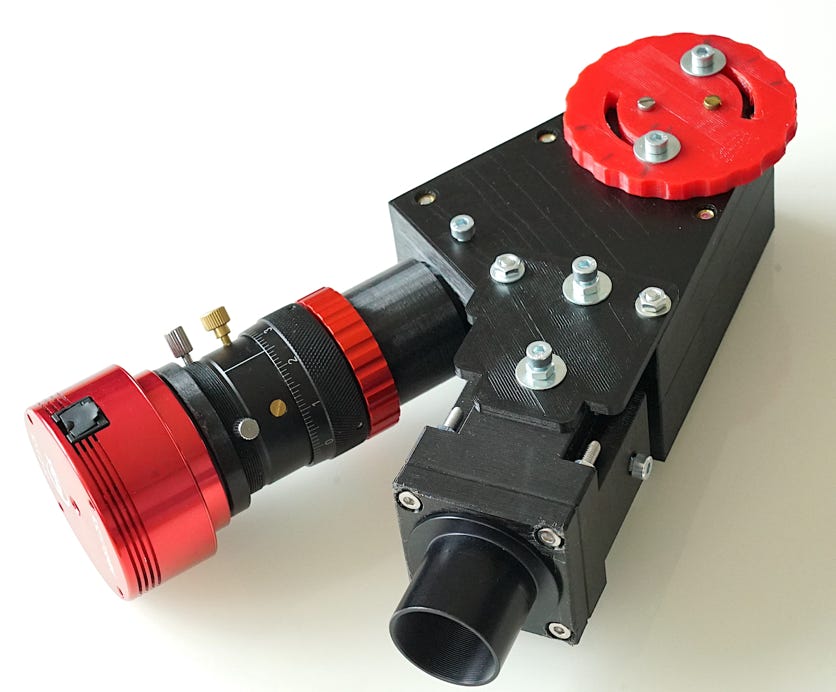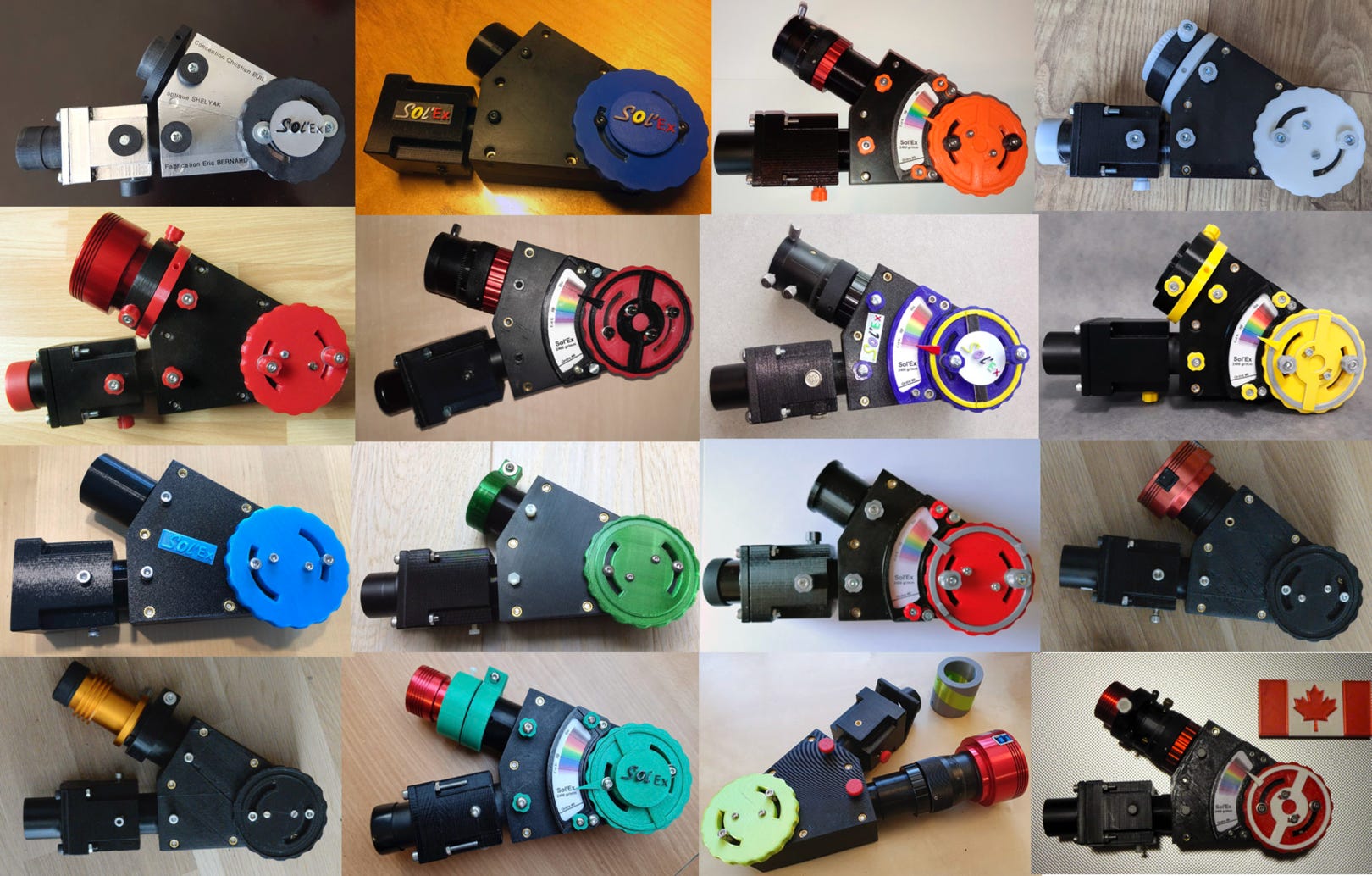
by Christian Buil
The Solar Explorer - October 25, 2023

by Christian Buil
The Solar Explorer - October 25, 2023
The 11-year solar cycle 25 is starting, it's time to gear up to observe activity on our Star's surface! This is the goal of the Sol'Ex project: the "Solar Explorer". Sol'Ex is an easy-to-build, cheap and compact 3D-printing astronomical instrument. It is optimized to be used with small size refractors and reflectors. It offers the possibility to discover the atmosphere of the Sun at various element wavelengths: hydrogen, calcium, helium ... and to follow its evolution from minute to minute. It also gives you the opportunity to learn about techniques that may be new to you.
Photograph of the Sun atmosphere grabbed by Sol'Ex as seen in the ionized calcium K ray line.



What does it take to build Sol’Ex?
◆ A set of mechanical parts made exclusively in 3D printing by yourself if you have a printer, by friends or by calling on a specialized company (see "Construction" section).
◆ Optical parts (a narrow slit, two lenses, a diffraction grating), which you can buy separately on the market, or better because more economical and efficient, in the form of a complete kit (see section "Contact" ).
◆ An electronic camera, CMOS type, to record data on a computer. An economical model with a small sensor will do. Without a doubt, you will find many other uses for this type of camera if you have to invest for the occasion!
◆ An astronomical refractor to take an image of the Sun. A modest diameter between 40 and 120 mm is perfect. You can even use a photographic telephoto lens, we will have the opportunity to show it. In some situations, an equatorial mount is not even necessary.
◆ A filter to attenuate solar flux at the entrance of the refractor or a Hershel helioscope (see "Observation" section).
◆ Enthusiasm and the desire to think outside the box!

The solar protuberances observed thanks to Sol'Ex (120 mm diameter refractor).
The Sol'Ex instrument was designed by seeking the right balance between its cost, its performance, its ease of use, its flexibility and the pleasure that one can experience by making it with one's fingers, while learning.
The performance of Sol'Ex is based on a very simple and classic optical scheme, but optimized for the need (see section "Theory"). This highlights the compact and small pixel CMOS cameras available today.
For a production cost of Sol'Ex we can range between 450 and 600 euros depending on your manufacturing facilities, you have the equivalent of a specialized filter for solar observation with a spectral width of 0.3 angstrom You can freely select the wavelength, which filters do not allow.
Thanks to a structure made in 3D printing, the mechanical and optical assembly of Sol'Ex weighs less than 500 grams. In other words, when combined with a small astronomical refractor or a photographic lens, this observation companion will be discreet, for example mounted in parallel with a larger instrument or attached to a small mount. You will not hesitate to use it.
Incidentally, I say a word about it in the "Star" section of this site: it is easy to transform Sol'Ex into an instrument specializing in the observation of these other suns that are the stars, or any other source of light, which you can then analyze spectrally.
Finally, I wanted the construction and use of Sol’Ex to be a small educational adventure for an individual, members of a club or the students. Realizing Sol'Ex allows you to discover or rediscover fields as stimulating as 3D printing, applied optics, image processing, physics and astrophysics. Granted, you're going to have to tune in to a device that lacks the refinements of more expensive equipment, but the effort is worth it and is part of the game.
Sol’Ex is an evolving observation instrument, already produced and used in dozens of examples around the world, where everyone makes their contribution. A small sample ...

The principle of Sol’Ex is that of the spectroheliograph, one of the most spectacular astronomical instruments to build and use. Many experienced enthusiasts have described how it works, so I would gladly give the floor to:
Sylvain and André Rondi: http://www.astrosurf.com/rondi/obs/shg/
Philippe Rousselle: http://astrosurf.com/spectrohelio/shg1.php
In short, the observation method consists to scan in right ascension on the spectrograph entrance slit. The long axis of the slit is perpendicular to this movement. Simultaneously, spectrum images are captured at high speed. A posteriori, the sequence of images is taken up by computer processing to build the image of the Sun line by line using an area of interest in the spectrum (a spectral line, for example). Typically, 2,000 to 5,000 images of the spectrum are acquired during the time the sun passes in front of the slit. Refer to the "Observation" section for details. Many videos are available; showing how this happens in practice on the ground.

Sol’Ex can easily be transformed into a powerful spectrograph to capture the spectrum of stars. He then becomes Star’Ex, the Star Explorer. Both an easily affordable educational tool, and an astrophysical research tool just waiting to be widely disseminated. Star’Ex is described in detail in the “Stars” section of this site.


Enjoy your discovery of the Sol'Ex project and have a good trip with it!
Copyright (C) 2020-2023 Christian Buil
Web : www.astrosurf.com/buil